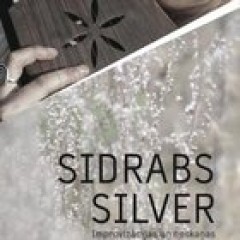
The kokle, a Latvian stringed instrument somewhat similar to the zither, has long been part of Latvian folk culture. The instrument has fitted into the stereotypical image of the Latvian folk maiden – in her folk costume, playing the kokle at the Song Festival (when she’s not milking the cows, of course).
Though it is an ancient instrument, and many might consider it a quaint bit of Latvian folklore, the kokle is very much a part of modern Latvian music. For example, there is Māris Muktupāvels of the post-folk group Iļģi, whose kokle playing is an integral part of the ensemble’s sound. Māris’ brother, ethnomusicologist Valdis, is also a renowned kokle performer, and has even written a book about the instrument. Biruta Ozoliņa performs the kokle in her ethno-jazz ensemble Patina. And that’s just to name a few.
Among those that are bringing this ancient instrument into the 21st century is the young musician Laima Jansone. Jansone has already performed with the Latvian Radio Choir – playing the kokle on a number of the songs on the Choir’s album Skaisti dziedi, released in 2008. Jansone has also performed with the vocal ensemble Latvian Voices, as well as Skyforger and Auļi. In 2011, Jansone released her first solo album – Sidrabs, a collection of solo kokle improvisations.
The improvisations are generally on a winter theme. Though they are improvisations, inspiration is drawn from Latvian folk songs and folklore – for example, the song “Sidrabs” quotes from the Latvian folk song “Sidrabiņa lietiņš lija”.
Judging from the song titles, the concepts presented are fairly simple – the works have titles like “Iela” (Street), “Upe” (River) and “Zāle” (Grass), but these are purely the sources of inspiration for the works – the actual performances are quite engrossing and compelling.
“Upe” features Jansone using the kokle as a percussion instrument, striking both the strings and the instrument itself, and then launching into a bravura performance that reminds the listener of a fast flowing river. “Piles”, as its corresponding video reinforces, gives the impression of a slowly melting icicle.
The album is also accompanied by a companion DVD, featuring the same tracks as the CD, each with an associated video, produced by Olafs Okonovs. The videos are, for the most part, fairly simple – for example, the video for “Iela” shows what seem to be headlights in the distance, the video for “Upe” has flowing water, etc. Interestingly, the video for “Atdzimšana” features a shadowy nude female form. Additionally, only Jansone’s fingers appear in the videos – this gives the viewer a better appreciation for how truly nimble and agile her playing is. The DVD is one that could be played in a spa or relaxation center. Otherwise the videos are a bit repetitive, and might not stand up to repeat viewing – except, of course, “Atdzimšana”.
Sidrabs is most certainly a worthy new entry in the Latvian kokle music genre – balancing both the ancient and the modern, the songs on the album provide a picturesque and beautiful winter landscape. Laima Jansone’s performances are very melodic and almost entrancing at times. Though slightly on the shorter side (under 40 minutes), that brief period of time is riveting and engrossing, both for Jansone’s virtuoso playing as well as the dreamy winter moods it presents. Sidrabs is an exceptional achievement, and we can look forward to hearing the next chapter!
More on the Laima Jansone website.
Details
Sidrabs
Laima Jansone
Kalve Studija, 2011
Track listing:
1. Pirmais (First)
2. Sidrabs (Silver)
3. Iela (Street)
4. Upe (River)
5. Zāle (Grass)
6. Piles (Drops)
7. Ceļš (Road)
8. Putenis (Blizzard)
9. Atdzimšana (Rebirth)
© 1995-2024 Latvians Online
Please contact us for editorial queries, or for permission to republish material. Disclaimer: The content of Web sites to which Latvians Online provides links does not necessarily reflect the opinion of Latvians Online, its staff or its sponsors.




